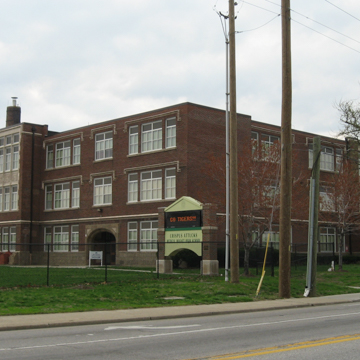Crispus Attucks High School was the only all-black high school built in Indianapolis. Located northwest of downtown Indianapolis, near the city’s primarily African American neighborhoods, this section of the city occupied undesirable land near the abandoned Central Canal, Fall Creek, and the White River, and had seen sparse development compared to other areas near downtown. The site fronts Dr. Martin Luther King Jr. Street (originally West Street) and sits on the north edge of the Ransom Place neighborhood, not far from Indiana Avenue, the primary commercial street for black-owned businesses.
Up until World War I, several segregated elementary schools were established in Indianapolis for African American children. Since the 1870s, those few who went further were permitted to attend the two public high schools along with white pupils. But as the black population increased at the onset of the Great Migration, the influence of Jim Crow segregation began to spread through Indianapolis’s public institutions. The 1920s brought the rise of the Ku Klux Klan in Indiana, and white supremacy groups—and even the Indianapolis Chamber of Commerce—petitioned the school board for a separate black high school. Opposing this idea were the city’s African American churches and groups such as the Better Indianapolis League, a civic organization of progressive black citizens. Ignoring the opposition, the school board voted unanimously to build a separate high school in December 1922. Protests continued, but ten months later, the architectural firm Harrison and Turnock was chosen to design a school “for the colored pupils of the city, modern in construction and appointments.”
Black community leader Archie Greathouse began a series of court battles protesting the establishment of a separate colored high school, which effectively held up construction for nearly two years, but the school board’s attorneys prevailed. In June 1925 the board arbitrarily decided to name the new school “Thomas Jefferson High School,” but the black community felt strongly that if there must be a separate black school, it should be named for a prominent African American. Of the numerous petitions to change the name, poet Paul Dunbar’s name was high on the list, but ultimately the school was named in honor of Crispus Attucks, the former slave killed in the 1770 Boston Massacre who is generally considered the first casualty of the American Revolution.
Harrison and Turnock’s design exhibits elements of Collegiate Gothic and Tudor Revival. The original three-story red brick building rests upon a polished granite foundation and has limestone sills and lavish terra-cotta trim. The main east facade has fifteen bays in groups of three, the center marked by a projecting one-story entrance pavilion topped with a terra-cotta balustrade. Separated by Corinthian columns, its three round arches boast spandrels ornamented with an open book design, all in terra-cotta. Above the entrance, between the second and third floors, are three rectangular terra-cotta tablets depicting musical instruments. The school’s name is inscribed beneath the cornice. The interior of the building features an unusual amount of terra-cotta as well. In 1938, using Public Works Administration funds, the venerable Indianapolis firm of D. A. Bohlen and Son built a much needed large addition to the school. It included ten classrooms and was designed to provide shop and home economics training as well as a gymnasium for physical education. In 1966, a modern gymnasium was added to the west of the old gym.
From its completion in 1927 until 1949, the school provided the only opportunity for black students in Indianapolis to receive a free secondary education. It became a focal point of pride for its community; the black faculty was the finest available, with many holding advanced degrees. In 1949, school segregation was outlawed in Indiana, but white flight from Indianapolis’s urban neighborhoods ensured that Crispus Attucks remained almost exclusively black. Indianapolis and Marion County governments merged in 1970, but the eight suburban township school systems ringing the Indianapolis Public Schools district were not consolidated, allowing districts to maintain racial segregation. In 1971, Indianapolis Public Schools were found guilty of de jure segregation and a busing order was imposed to achieve racial integration with the surrounding suburban townships. In the early 1980s, the city’s public high schools were reorganized, and Crispus Attucks High School became a junior high for a time. Since 2006, it has been known as the Crispus Attucks Medical Magnet High School.
References
“Crispus Attucks High School.” National Park Service. Accessed March 14, 2018. https://www.nps.gov/.
Greiff, Glory-June, and Blanche Stewart, “Crispus Attucks High School,” Marion County, Indiana. National Register of Historic Places Registration Form, 1988. National Park Service, U.S. Department of the Interior, Washington, D.C.
Greiff, Glory-June, “Crispus Attucks High School,” Marion County, Indiana. Indianapolis Public Schools Thematic Resources Nomination, 1985.
Minutes, 1830-1930. Board of School Commissioners of the City of Indianapolis. Indianapolis Public Schools, Indianapolis, Indiana.
Warren, Stanley. “Crispus Attucks High School.” In Encyclopedia of Indianapolis. Edited by David J. Bodenhamer and David Gordon Vandestel. Bloomington: Indiana University Press, 1994.








